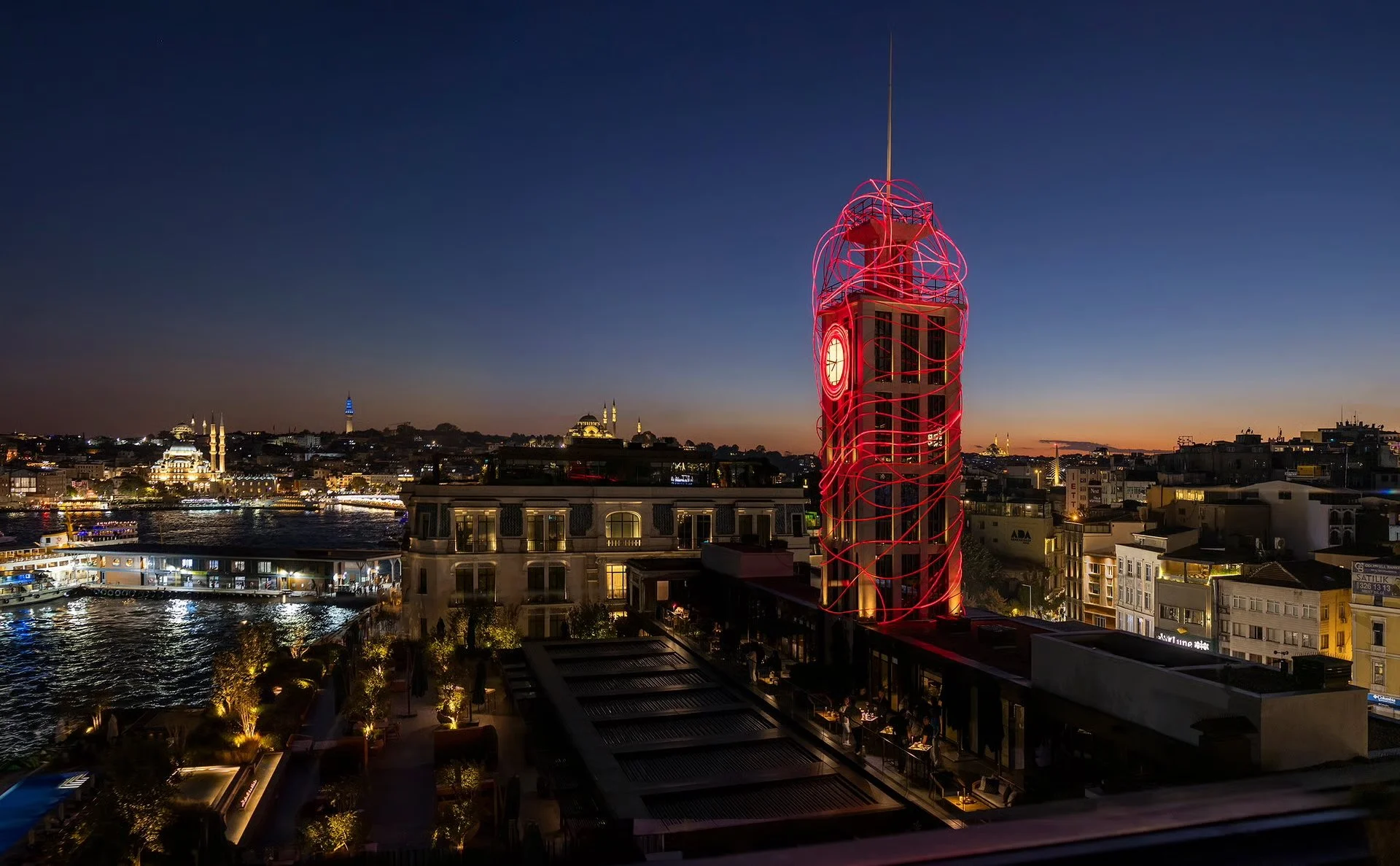Focus America at Contemporary Istanbul
Whirling tornado wisps of electric red encircled a clock tower over Istanbul’s new shorefront urban renewal project, Galataport, where Peruvian-born American artist Grimanesa Amorós installed PASSAGE (2025), a public light work affixed atop the shorefront hotel, The Peninsula, overlooking the Bosphorus.
To mark its 20th year, Contemporary Istanbul, Turkey’s flagship art fair, hosted several American artists, galleries, and speakers to align with its curatorial theme, “Focus America.” Sarp Kerem Yavuz, Artistic Director of the Contemporary Istanbul Foundation, presided over talks by Jennifer Stockman, President Emeritus of the Guggenheim, Anne Pasternak, Director of the Brooklyn Museum, and others, noting authoritarian trends in US politics and culture all too familiar to their Turkish counterparts in the art world.
“Art is especially important in today’s world, given the global instability all around us,” Stockman said in her keynote speech for the Contemporary Istanbul Foundation Dialogues, including American artist Summer Wheat, LACMA’s Associate Curator of Chinese Art Susie Ferrell, and Director of Times Square Arts Jean Cooney. “Having participated in the art world for maybe thirty years, I have seen how shifts in culture and institutions have reverberated globally, reshaping the perception of art as both an economic driver and a civic necessity,” Stockman continued.
With retrospective insight, Contemporary Istanbul exhibited the first BMW art car design by American sculptor Alexander Calder, shown for the first time beside the latest iteration by Ethiopian-born American painter Julie Mehretu. These flashy visions of commercial exposure were flanked by the digital artworks of Turkish artist Ecem Dilan Köse, whose black cube of audio-visual liquidity Flow (2025) offered a sensory refuge against the monumental shimmer of Güvenç Özel’s HOLOFLUX (2025), flickering nightly over the inner city inlet of the Golden Horn.
The shameless extroversion that defines much of public programming at art fairs throughout the world was no less visible at Contemporary Istanbul, a sensibility fine-tuned by Cooney, who is also VP of Arts and Culture at the Times Square Alliance. She spoke for the first panel of Contemporary Istanbul Foundation Dialogues, titled “Making Space for the Public.”
“How do you think about place-making in a space that has a fairly fixed perception in the public consciousness?” Cooney asked in the face of “East-meets-West” orientalist stereotypes that continue to overshadow Istanbul’s modernist reinventions.
Converting the 600-year-old Ottoman shipyard of Tersane Istanbul into the fairgrounds of Contemporary Istanbul animated the historic, industrial space as a site for modern culture much in the way that Times Square Arts envisions its transformative role in New York City, where up to 300,000 visitors see Times Square every day. Every night from 11:57 to midnight, Times Square Arts synchronizes video art on 95 billboards for Midnight Moment. “How do you give people pause and have space for any meaningful type of participation or engagement in a place that’s really designed to dazzle and distract simultaneously?” Cooney wondered. “It’s not just a commercial district, it’s a cultural district, it’s a public space, and I think that disruption is really important in our most trafficked spaces, especially Times Square.”
One of the free public outreach exhibitions at Contemporary Istanbul featured an installation by Judy Chicago, What If Women Ruled The World (2022–), with Nadya Tolokonnikova, effectively functioning as a tapestry knit together with portraits of women and their quotes answering the titular question along with follow-ups such as “Would Buildings Resemble Wombs?” or “Would There Be Violence?” The piece will circulate around the globe with contributions from the Turkish women who visited during Contemporary Istanbul.
Summer Wheat’s mosaic mural, Subterranean Garden (2025), blossoms in the brick-arched courtyard of Tersane Istanbul. “My painting technique is often mistaken for tapestry. Since 2017, I have incorporated mosaic works into my practice, and there’s a lot of mosaic work in Byzantine art, so it’s a natural connection,” said the artist, who has been traveling to Turkey about once every year since 2013 and participated in Aliée Istanbul’s first artist-in-residence program.
American galleries are strongly represented in the booths at this year's Contemporary Istanbul. New York-based HEFT showed the maximally pointillist Quantum Entanglement paintings (2025) of Nancy Burson. Pontone Gallery stunned with compositions of LED backlit tempered glass by Hwang Seontae, conveying sunny interiors with tactile realism. Chelsea Culprit with Revolver Galería offered a cubist hallucination with High Spirited Chimeras With Hypnotic Digital Masks I (2018), all with appetizing stylistic decorum befitting fair-inspired salability.
To conclude the Contemporary Istanbul Foundation Dialogues, Anne Pasternak conversed with museum developer Emin Mahir Balcıoğlu, whose work has been instrumental in founding Turkey’s modern art museums, serving as the first director of Istanbul Modern while advancing the country’s relatively nascent institutions to American and global standards.
“Why would anybody want to be a director if they might go to prison if something gets lost or stolen?” Pasternak asked Balcıoğlu, referring to the protocol for museum directors in Turkey, where government oversight tends to be punitive, before focusing on America’s politicization of culture. “When you think of the role that culture plays in helping to fight back authoritarianism, humor is actually a very important tool,” said Pasternak. “We need strong educational and cultural institutions to help tell truthful stories, to share facts, to open hearts and minds, to create experiences of not just wonder but also dignity, to lean into history and to the present and to imagine a better future.”
“Our cultural institutions have been increasingly weakened over the years. It’s not just with this administration. We’ve been weakened by all sides,” Pasternak added, shaking hands with Balcıoğlu as she grinned, betting against the prospect that elections would even continue in the US. “There is hope, but not for us,” Balcıoğlu responded with laughter, attributing his pessimism for Turkey to the words of Kafka.
Contemporary Istanbul ran from September 24 through 28, 2025.




